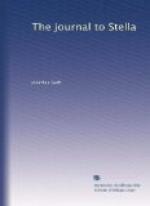23 Charles XII.
24 “Is” (Ms.).
25 Cibber says that he saw four acts of Cato in 1703; the fifth act, according to Steele, was written in less than a week. The famous first performance was on April 14, 1713.
26 The first number of the Guardian appeared on March 12, and the paper was published daily until Oct. 1, 1713. Pope, Addison, and Berkeley were among the contributors.
27 See Letter 52, note 6.
28 See Letter 39, note 16.
29 The first preached after the period of his suspension by the House of Lords. It was delivered at St. Saviour’s, Southwark, before his installation at St. Andrew’s, and was published with the title, “The Christian’s Triumph, or the Duty of praying for our Enemies”.
30 Swift’s curate at Laracor.
31 Richard Gorges (died 1728) was eldest son and heir of Dr. Robert Gorges, of Kilbrue, County Meath, by Jane, daughter of Sir Arthur Loftus, and sister of Adam, Viscount Lisburne. He was appointed Adjutant-General of the Forces in Ireland 1697, Colonel of a new Regiment of Foot 1703, Major-General of the Forces 1707, and Lieutenant-General 1710 (Dalton’s Army Lists, iii. 75).
32 See Letter 60, note 10.
33 Mrs. Oldfield.
34 See Letter 56, note 6.
35 Never saw the like.
36 See Letter 53, note 10.
37 The remainder has been partially obliterated.
Letter 63.
1 Addressed to “Mrs. Dingley,” etc. Endorsed “May 4.”
2 Lord Cholmondeley (see Letter 36, note 15).
3 Harcourt.
4 Forster’s reading; the last two words are doubtful.
5 See Letter 7, note 27.
6 Francis Palmes, who was wounded at Blenheim, was made a Lieutenant-General in 1709. In 1707 he was elected M.P. for West Loo; in 1708 he was sent as Envoy Extraordinary to the Duke of Savoy, and in 1710 to Vienna.
7 Apparently “so heed.”
8 Henry Villiers (died 1743), second son of the first Earl of Jersey and of Barbara, daughter of William Chiffinch (see Letter 29, note 3 and Letter 59, note 25).
9 See Letter 61, Mar. 8, 1712-13. The Speech and Address are in the Commons’ Journals, xvii. 278, 28O. For the draft Address, in Swift’s handwriting, see the Portland Papers (1899), v. 276.
10 Scoffed, jeered.
11 Dr. Gastrell (see Letter 25, note 8).
12 George Berkeley, afterwards Bishop of Cloyne, but then a young man of twenty-eight, came to London in January 1713. He was already known by his “New Theory of Vision” and “Treatise on the Principles of Human Knowledge”, and he brought with him his “Three Dialogues between Hylas and Philonous”. Steele was among the first to welcome him, and he soon made the acquaintance of Addison, Pope, and Swift. On March 27, Berkeley wrote to Sir John Perceval of the breach between Swift and the Whigs: “Dr. Swift’s wit is admired by both of them (Addison and Steele], and indeed by his greatest enemies, and. . . I think him one of the best-matured and agreeable men in the world.” In November 1713 Swift procured for Berkeley the chaplaincy and secretaryship to Lord Peterborough, the new Envoy to Sicily.




